
FM 21-150 COMBATIVES 1992
.pdf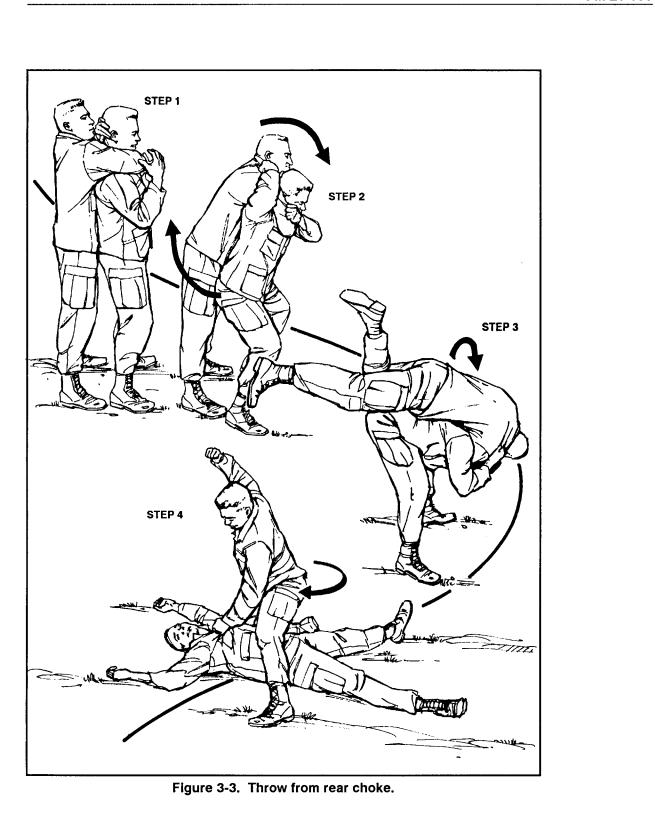
FM 21-150
3-7

FM 21-150
(4) Head butt. The head butt can be applied from the front or the rear. It is repeated until the opponent either releases his grip or becomes unconscious.
(a) The opponent grabs the defender in a bear hug from the front (A,Figure 3-4, Step 1).
The defender uses his forehead to smash into his opponent’s nose or cheek (A,Figure 3-4, Step 2) and stuns him.
The opponent releases the defender who then follows up with a kick or knee strike to the groin (A, Figure 3-4, Step 3).
(b) The opponent grabs the defender in a bear hug from the rear (B, Figure 3-4, Step 1).
The defender cocks his head forward and smashes the back of his head into the opponent’s nose or cheek area (B, Figure 3-4, Step 2).
The defender turns to face his opponent and follows up with a spinning elbow strike to the head (B, Figure 3-4, Step 3).
3-8
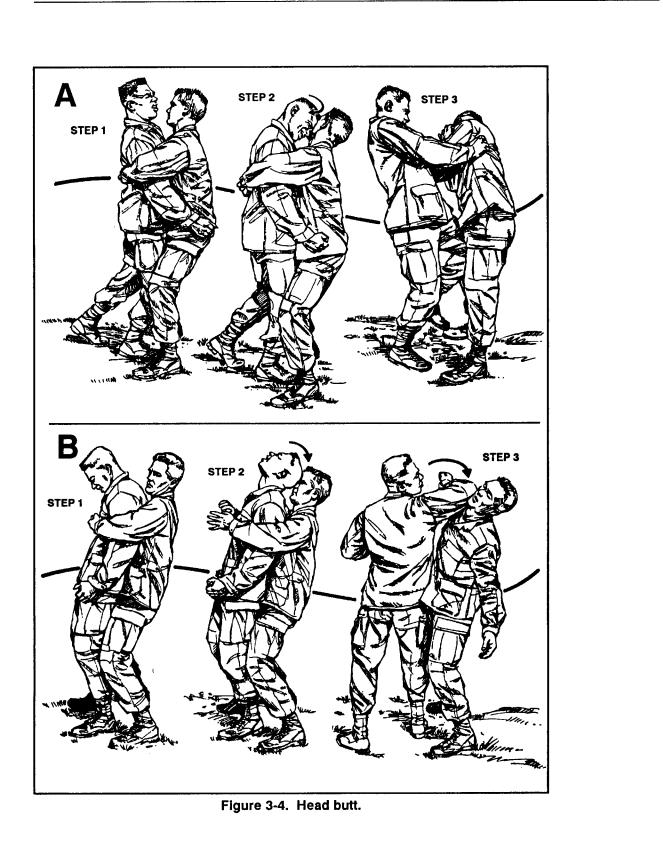
FM 21-150
3-9

FM 21-150
(5) Rear strangle takedown. The defender strikes the opponent from the rear with a forearm strike to the neck (carotid artery) (Figure 3-5, Step 1).
The defender wraps his right arm around his opponent’s neck, making sure he locks the throat and windpipe in the vee formed by the his elbow. He grasps his left bicep and wraps his left hand around the back of the opponent’s head. He pulls his right arm in and flexes it, pushing his opponent’s head forward (Figure 3-5, Step 2).
The defender kicks his legs out and back, maintains a choke on his opponent’s neck, and pulls his opponent backward until his neck breaks (Figure 3-5, Step 3).
3-10
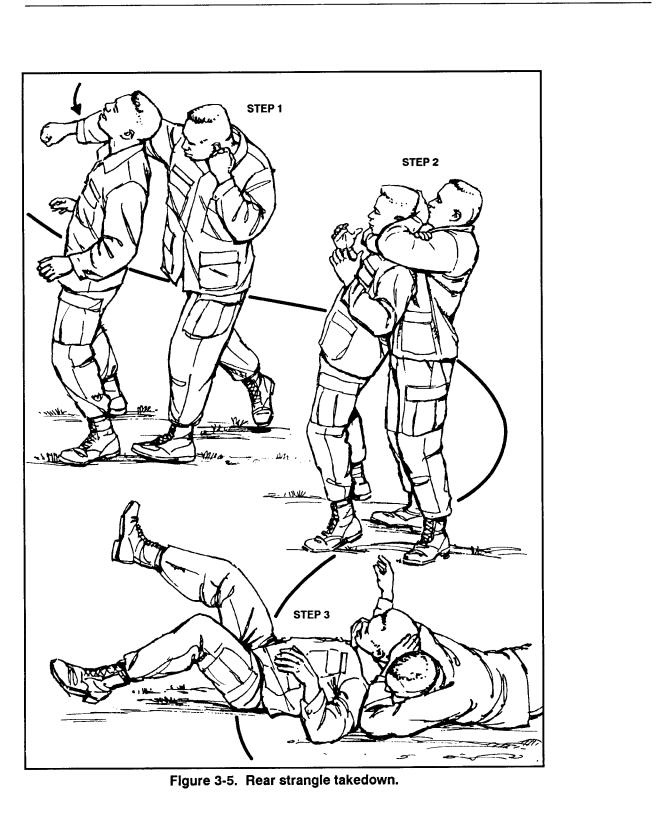
FM 21-150
3-11
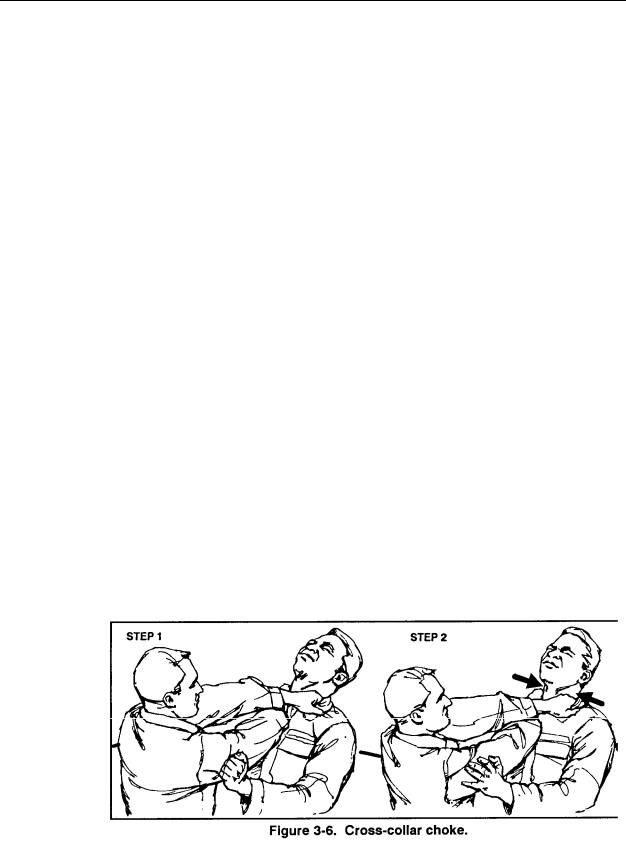
FM 21-150
3-2. STRANGULATION
Strangulation is a most effective method of disabling an opponent. The throat’s vulnerability is widely known and should be a primary target in close-range fighting. Your goal may be to break the opponent’s neck, to crush his trachea, to block the air supply to his lungs, or to block the blood supply to his brain.
a.Strangulation by Crushing. Crushing the trachea just below the voice box is probably one of the fastest, easiest, most lethal means of strangulation. The trachea is crushed between the thumb and first two or three fingers.
b.Respiratory Strangulation. Compressing the windpipe to obstruct air flow to the lungs is most effectively applied by pressure on the cartilage of the windpipe. Unconsciousness can take place within one to two minutes. However, the technique is not always effective on a strong opponent or an opponent with a large neck. It is better to block the blood supply to weaken the opponent first.
c.Sanguineous Strangulation. Cutting off the blood supply to the brain by applying pressure to the carotid arteries results in rapid unconsciousness of the victim. The victim can be rendered unconscious within 3 to 8 seconds, and death can result within 30 to 40 seconds.
3-3. CHOKING TECHNIQUES
There are several choking techniques that a soldier can use to defeat his opponent in hand-to-hand combat.
a. Cross-Collar Choke. With crossed hands, the fighter reaches as far as possible around his opponent’s neck and grabs his collar (Figure 3-6, Step 1). The backs of his hands should be against the neck.
The fighter keeps his elbows bent and close to the body (as in opening a tightly sealed jar), pulls outward with both hands, and chokes the sides of the opponent’s neck by rotating the knuckles into the neck (Figure 3-6, Step 2). The forearm can also be used.
3-12
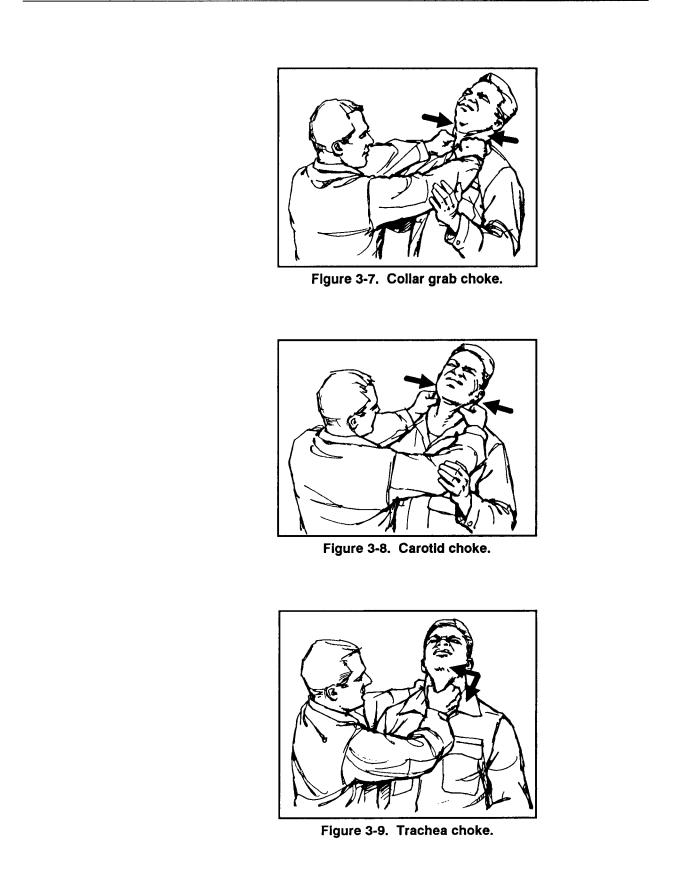
FM 21-150
b. Collar Grab Choke. The fighter grabs his opponent’s collar with both hands straight-on (Figure 3-7). He then rotates the knuckles inward against the neck to quickly produce a good choke. He also keeps the elbows in front and close to the body where the greatest strength is maintained.
c. Carotid Choke. The fighter grabs the sides of the opponent’s throat by the muscle and sticks his thumbs into the carotids, closing them off (Figure 3-8). This is a fast and painful choke.
d. Trachea Choke. The fighter grabs the opponent’s trachea (Figure 3-9) by sticking three fingers behind the voice box on one side and the thumb behind the other. He then crushes the fingers together and twists, applying pressure until the opponent is disabled.
3-13
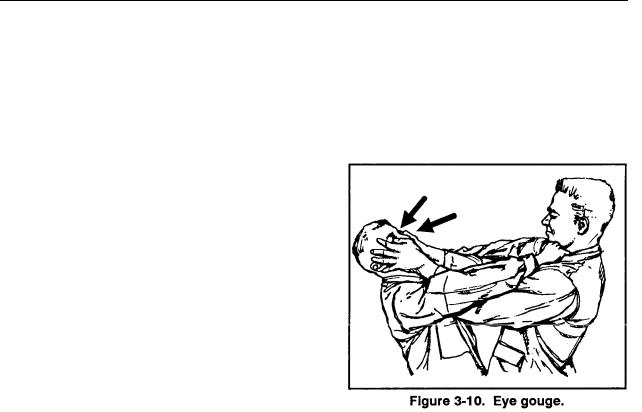
FM 21-150
3-4. COUNTERS TO CHOKES
A soldier must know how to defend against being choked. Incapacitation and unconsciousness can occur within three seconds; therefore, it is crucial for the defender to know all possible counters to chokes.
a. Eye Gouge. The opponent attacks the defender with a frontal choke. The defender has the option of going over or under the opponent’s arms. To disable the opponent, the defender inserts both thumbs into his opponent’s eyes and tries to gouge them (Figure 3-10). The defender is prepared to follow-up with an attack to the vital regions.
b. Shoulder Dislocation. If the opponent applies a choke from the rear, the defender places the back of his hand against the inside of the opponent’s forearm (Figure 3-11, Step 1).
Then, he brings the other hand over the crook of the opponent’s elbow and clasps hands, keeping his hands close to his body as he moves his entire body around the opponent (Figure 3-11, Step 2).
He positions his body so that the opponent’s upper arm is aligned with the opponent’s shoulders (Figure 3-11, Step 3). The opponent’s arm should be bent at a 90-degree angle.
By pulling up on the opponent’s elbow and down on the wrist, the opponent’s balance is taken and his shoulder is easily dislocated (Figure 3-11, Step 4). The defender must use his body movement to properly position the opponent—upper body strength will not work.
He drops his body weight by bending his knees to help get the proper bend in the opponent’s elbow. The defender must also keep his own hands and elbows close to his body to prevent the opponent’s escape (Figure 3-11, Step 5).
3-14
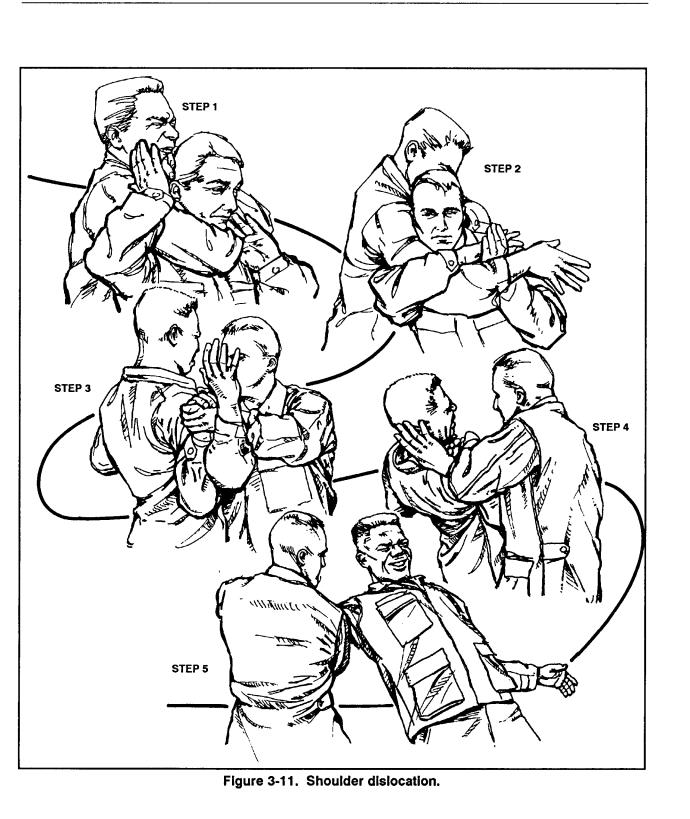
FM 21-150
3-15

FM 21-150
c. Weight Shift. To counter being choked from above while lying on the ground (Figure 3-12, Step 1), the defender places his arms against his opponent’s elbows and locks the joints.
At the same time, he shifts his hips so that his weight rests painfully on the opponent’s ankle (Figure 3-12, Step 2).
The defender can easily shift his body weight to gain control by turning the opponent toward his weak side (Figure 3-12, Step 3).
3-16
